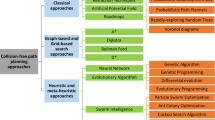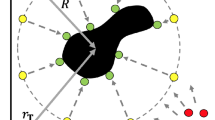Abstract
During the operation of space manipulators for debris removal, the obstacles moving in the workspace must be avoided. We propose a unified modelling framework for multiple moving obstacles and a collision-free trajectory planning method for a redundant space manipulator. The complete properties of an obstacle, including its shape, dimension, pose (position and orientation), and velocity (linear and angular), are defined in the model. The obstacle surface is represented by a super quadratic function whose parameters are adjusted to describe different shapes and dimensions. Pseudo-distance is defined to evaluate the proximity extent between the manipulator and an obstacle. Considering multiple different obstacles, we present an approach to normalize the pseudo-distances. The self-motion of the redundant manipulator was used to optimize the normalized pseudo-distance by adaptive redundancy resolution. By ensuring that the pseudo-distance was always larger than the safety threshold value, collisions with the obstacles were avoided. The proposed method solved the problem for which the Euclidean distance was difficult, or even impossible, to calculate for 3-D cases. When handling multiple different obstacles, the proposed method was much easier and had higher computational efficiency than previous methods. The proposed method was verified by the simulation of typical missions.
Similar content being viewed by others
References
A. E. White and H. G. Lewis, “An adaptive strategy for active debris removal,” Advances in Space Research, vol. 53, no. 8, pp. 1195–1206, 2014. [click]
Y.-K. Ma and H.-B. Ji, “Robust control for spacecraft rendezvous with disturbances and input saturation,” International Journal of Control, Automation, and Systems, vol. 13, no. 2, pp. 353–360, 2015. [click]
D.-K. Wang, P.-F. Huang, J. Cai, and Z.-J. Meng, “Coordinated control of tethered space robot using mobile tether attachment point in approaching phase,” Advances in Space Research, vol. 54, no. 6, pp. 1077–1091, 2014.
X. Xu and P. Huang, “Coordinated control method of space-tethered robot system for tracking optimal trajectory,” International Journal of Control, Automation, and Systems, vol. 13, no. 1, pp. 182–193, 2015. [click]
J.-G. Wang, Y.-M. Li, and X.-H. Zhao, “Inverse kinematics and control of a 7-DOF redundant manipulator based on the closed-loop algorithm,” International Journal of Advanced Robotic Systems, vol. 7, no. 4, pp. 1–9, 2010.
S. B. Nokleby, “Singularity analysis of the canadarm2,” Mechanism and Machine Theory, vol. 42, no. 4, pp. 442–454, 2007. [click]
R. V. Patel, F. Shadpey, F. Ranjbaran, and J. Angeles, “A collision-avoidance scheme for redundant manipulators: theory and experiments,” Journal of Robotic Systems, vol. 22, no. 12, pp. 737–757, 2005. [click]
Y. Dai and S.-G. Lee, “Formation control of mobile robots with obstacle avoidance based on GOACM using onboard sensors,” International Journal of Control, Automation, and Systems, vol. 12, no. 5, pp. 1077–1089, 2014. [click]
K. Glass, R. Colbaugh, D. Lim, and H. Seraji, “Real-time collision avoidance for redundant manipulators,” IEEE Transactions on Robotics and Automation, vol. 11, no. 7, pp. 448–457, 1995.
E. Yoshida, C. Esteves, I. Belousov, J.-P. Laumond, T. Sakaguchi, and K. Yokoi, “Planning 3D collision-free dynamic robotic motion through iterative reshaping,” IEEE Transactions on Robotics, vol. 24, no. 5, pp. 1186–1198, 2008.
V. Perdereau, C. Passi, and M. Drouin, “Real-time control of redundant robotic manipulators for mobile obstacle avoidance,” Robotics and Autonomous Systems, vol. 41, no. 1, pp. 41–59, 2002.
R. Colbaugh, H. Seraji and K. Glass, “Obstacle avoidance of redundant robots using configuration control,” Journal of Robotic Systems, vol. 6, no. 6, pp. 721–744, 1989. [click]
N. Rahmanian-Shahria and I. Trocha, “Collision-avoidance control for redundant articulated robots,” Robotica, vol. 13, no. 2, pp. 159–168, 1995. [click]
S. Bonner and R.-B. Kelley, “A novel representation for planning 3-D collision-free paths,” IEEE Transactions on Systems, Man and Cybernetics, vol. 20, no. 6, pp. 1337–1351, 1990.
F. Shadpey, C. Tessier, R.-V. Patel, B. Langlois, and A. Robins, “A trajectory planning and object avoidance system for kinematically redundant manipulators: an experimental evaluation,” Proc. of AAS/AIAA American Astrodynamics Conference, Halifax, NS, Canada, pp. 979–997, 1995.
S. I. Choi and B. K. Kim, “Obstacle avoidance control for redundant manipulators using collidability measure,” Robotica, vol. 18, no. 2, pp. 143–151, 2000. [click]
K. Hwang and M.-Y. Ju, “3D collision-free motion based on collision index,” Journal of Intelligent and Robotic Systems, vol. 33, no. 1, pp. 45–60, 2002.
S. R. F.-P. Saramago and V. S. E. Junior, “Optimal trajectory planning of robot manipulators in the presence of moving obstacles,” Mechanism and Machine Theory, vol. 35, no. 8, pp. 1079–1094, 2000.
E. Papadopoulos and S. Dubowsky, “On the nature of control algorithms for free-floating space manipulators,” IEEE Transactions on Robotics and Automation, vol. 7, no. 6, pp. 750–758, 1991.
K. Yoshida, “Engineering test satellite VII flight experiments for space robot dynamics and control: theories on laboratory test beds ten years ago, now in orbit,” International Journal of Robotics Research, vol. 22, no. 5, pp. 321–335, 2003.
R. V. Patel, F. Shadpey, F. Ranjbaran, and J. Angeles, “A collision-avoidance scheme for redundant manipulators: theory and experiments,” Journal of Robotic Systems, vol. 22, no. 12, pp. 737–757, 2005.
Z. Mu, W. Xu, X. Gao, L. Xue, and C. Li, “Obstacles modeling and collision detection of space robots for performing on-orbit services,” Proc. of 2014 4th IEEE International Conference on Information Science and Technology (ICIST), Shenzhen, China, pp. 461–466, 2014.
Author information
Authors and Affiliations
Corresponding author
Additional information
Recommended by Associate Editor Juhoon Back under the direction of Editor Myo Taeg Lim. This work was supported in part by the National Natural Science Foundation of China (61573116, U1613227), the Foundation for Innovative Research Groups of the National Natural Science Foundation of China51521003), and the Basic Research Program of Shenzhen (JCYJ20160427183553203; JCYJ20150529141408781).
Zonggao Mu received the B.E. degree in Mechatronics engineering, from Shandong University of Science and Technology, Qingdao, Shandong, China in 2011, and the M.E. degree in Mechatronics engineering, from Harbin Institute of Technology Shenzhen Graduate School, Shenzhen, China in 2013. He is currently pursuing a Ph.D. degree in Mechanical Engineering. His research interests include space robotics, redundant manipulator.
Wenfu Xu received the B.E. degree in 2001, and the M.E. degree in 2003, both in control engineering, from Hefei University of Technology, Hefei, China, and the Ph.D. degrees in the control science and engineering from Harbin Institute of Technology, Harbin, China, in 2007. He was a research associate (as a visiting scholar, from Feb. 22, 2013 to Feb.21, 2014) with the Dept. Mechanical and Automation Engineering, The Chinese University of Hong Kong, Hong Kong, China. He is currently a Professor with the Department of Mechanical and Automation Engineering, Harbin Institute of Technology Shenzhen Graduate School, Shenzhen, China. His research interests include space robotics, multi-body system dynamic, redundant manipulator.
Bin Liang received the B.S. and the M.S. degrees in control engineering from Northwestern Polytechnical University, Xi-An, China, in 1991 and 1994 respectively, and the Ph.D. degree in precision instrument and mechanology from Tsinghua University, Beijing, China, in 1994. He is currently a professor with the Department of Automation, Tsinghua University, Beijing, China. His research interests include space robotics, manipulators and intelligent control.
Rights and permissions
About this article
Cite this article
Mu, Z., Xu, W. & Liang, B. Avoidance of multiple moving obstacles during active debris removal using a redundant space manipulator. Int. J. Control Autom. Syst. 15, 815–826 (2017). https://doi.org/10.1007/s12555-015-0455-7
Received:
Revised:
Accepted:
Published:
Issue Date:
DOI: https://doi.org/10.1007/s12555-015-0455-7




